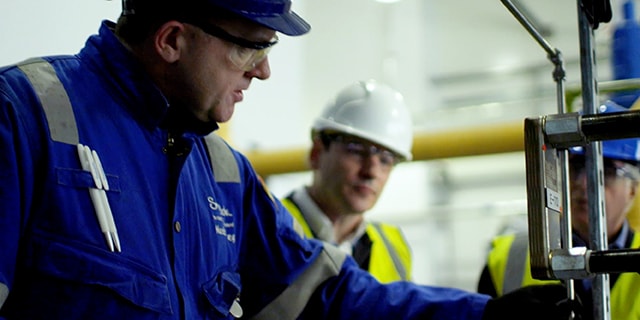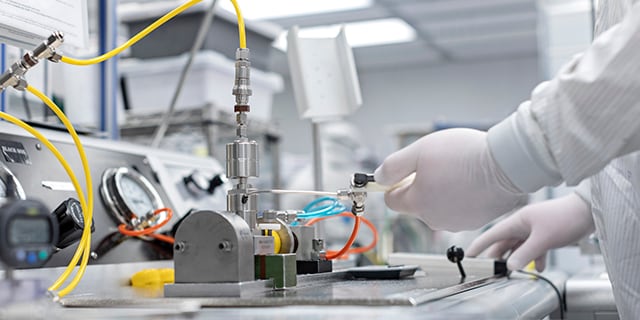How to Optimize Semiconductor ALD Processes

How the Right Valve Can Improve Accuracy and Consistency in Your ALD Process
The challenge of maximizing throughput combined with the increasingly complex and precise processes needed to manufacture the latest microchip is driving semiconductor manufacturers to pursue tighter and tighter process controls. Achieving narrower performance tolerances in production processes such as atomic layer deposition (ALD) is essential to optimizing production chip yields.
This precision in the chemical dosing and delivery system is a critical element of an optimally productive ALD process. And a well-designed valve control system can help. We’ll explore the reasons why, beginning with an important conundrum semiconductor scientists encountered—and overcame—at a pivotal point in the technology’s ongoing evolution.
A Brief History of the Semiconductor Industry
The semiconductor industry got its start in Silicon Valley in the 1960s, but by the late 1990s, the scientific community was anticipating an impending barrier to the progression of Moore’s Law—the observation that the number of transistors per silicon chip doubles about every two years. This was associated with the technical limits of traditional dielectric layers in devices, and the industry knew that a dielectric material to replace SiO2 would soon be needed.
This was a challenge because SiO2 was convenient to “grow” and maintained excellent precision and uniformity on silicon wafers. Depositing a new dielectric material using more traditional deposition methods like CVD or PVD would not be easy.
It was then that the ALD process emerged as a novel way to apply new materials with precise film thicknesses. In the early stages, there were some major barriers to entry, including slow deposition rates, but over time the industry developed more effective ways to implement ALD in semiconductor fabrication. It quickly became clear that ALD would become important to the future of semiconductor device fabrication, but there were still some chemical delivery challenges with which to contend.
The Importance of Valves in the ALD Process
Semiconductor fabricators are working to maintain subnanometer precision in deposited films over the area of a 300 mm diameter wafer. That is the scaled equivalent of applying a 1-cm-thick layer over the entire surface of the moon. In modern semiconductor devices, it only takes a few extra atoms of variation to noticeably influence the device’s performance.
Semiconductor fabricators are working to maintain subnanometer precision in deposited films over the area of a 300 mm diameter wafer. That is the scaled equivalent of applying a 1-cm-thick layer over the entire surface of the moon.
A major factor that influences the deposited layers is the concentration of chemicals in the atomic layer process steps. This requires high precision in the amount of chemical delivered during each dose. Specialized, high-purity ALD valves are a necessity to stop and start the flow of chemicals into the process chamber precisely and consistently.
Characteristics to Look for in ALD Valves
Considering that an ALD process often involves hundreds of dosing steps, the process valves see a lot of action—sometimes more than a million cycles per week. Thus, there is a need for very high cycle reliability. And because process valves sometimes function as the flow-limiting element in the system, flow capacity and consistency can be important. Flow consistency from valve to valve can also be important for achieving process matching and in maintaining a consistent process after valves are changed.
Considering that an ALD process often involves hundreds of dosing steps, the process valves see a lot of action—sometimes more than a million cycles per week. Thus, there is a need for very high cycle reliability.
Actuation response time and consistency are also important—any change in the valve response time that impacts the dose duration also impacts the volume of the delivered dose. For example, a faster valve open response time and slower close response time increase the dose duration. For a 100-millisecond dose time, a 3-millisecond shift in the open and close times can increase the dose volume 6%, which in many atomic layer applications would be quite significant to the process outcome.
Raw actuation speed can also help improve the efficiency of a process that can sometimes involve hundreds of dosing steps. Faster actuation can mean reducing the time for each step, which can contribute to a significant reduction in the total processing time.
It is also important to remember that valves with high, consistent flow and fast, repeatable actuation are only useful if they are compatible with the chemicals being delivered and the temperatures of the delivery system. In many cases, particularly in ALD, the chemical precursors can condense or deposit on surfaces that are not maintained at a sufficient temperature, which can have ill effects on the process.
Additional ALD Process Considerations
ALD process repeatability is unambiguously linked to the consistency and accuracy of the discrete chemical doses employed—and anything that can cause a change or difference in the chemical doses will cause a change or difference in the associated process. All atomic layer deposition equipment components that exist between the base chemical and the wafer surface have the potential to influence the chemical dose, making it important to select high-quality tubing and fittings throughout the entire system.
Finally, a pneumatic actuation system that controls a process valve plays an important role in defining the speed and consistency of an ALD valve. Actuation pressure and tolerance, air supply and exhaust tubing size and lengths, pilot valves, and even the pneumatic fittings used can all impact process valve timing, which is important in any atomic layer process. An ultra-consistent ALD process valve is not enough on its own—a pneumatic system to operate the valve and, in some cases, sensors to accurately monitor valve timing performance is also critical.
How OEMs and Fabs Can Achieve Reliable ALD Consistency
Working with a knowledgeable team that understands the challenges associated with the ALD process is a good first step. Suppliers and consultants who understand the challenges inherent to atomic layer processes and who have experience solving them can go a long way toward enhancing accuracy and consistency in your ALD processes.
At Swagelok, our team has been supporting customers throughout the semiconductor industry as atomic layer processes have evolved and matured over the years, and we are happy to continue offering our assistance along that ongoing journey. Interested in learning more about how the right valve technology and system configurations can help improve your ALD processes? We’re continuously working to develop the right solutions to help set fabs up for ongoing success. Browse our portfolio or get in touch with our semiconductor specialists to learn more.
Related Articles

Building More Profitable Semiconductor Fabs
Learn why choosing high-quality fluid system parts and assemblies can contribute to faster semiconductor fabrication facility construction, and lower total cost of ownership over the facility’s lifetime.

Vacuum Face Seal Fittings Explained
Learn why vacuum face seal fittings represent an ideal solution for uncompromising ultrahigh-purity semiconductor fluid system applications.

Why Fast Support Matters for Semiconductor Fabs
Reducing total cost of ownership for semiconductor fabs is possible by working with suppliers that can provide fast, local support for critical challenges. Find out how Swagelok can help.

